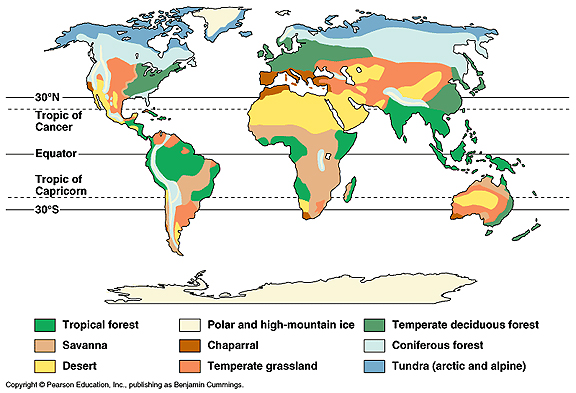Biomes and Climate

Guiding Questions:
-How do animal interactions affect each other and their environment?
-What determines how many species live in a given place?
-What determines how large each population can grow?
Levels of Organization
Population - all the members of a single species
Community
- all of the different populations in an area
Ecosystem - the living (biotic) and nonliving (abiotic) factors
Biome - large areas with a certain climate that support specific types of plants and animals (desert)
Biosphere - the part of the eart that can support life
Three Main Climate Zones:
- Polar (cold areas near the poles)
- Temperate (areas that have hote and cold seasons)
- Tropical (near equator, always warm)
Major Biomes
- Color North American Biomes
- Biome Viewer at HHMI
- Biome Project
- Biomes Concept Map
- Analyzing Dita - Biome Graph
TROPICAL RAIN FOREST
has most species
canopy = top
understory = second story below canopy
hot & wet year round; thin, poor soil
rainfall is seasonal not year-round
trees are deciduous -lose leaves
warm year round; wet/dry seasons; rich soil
TROPICAL SAVANNA
less rainfall than dry forest, but more than desert
covers of grasses spotted with trees
large animal herds & frequent fires
lions & giraffes
DESERT
dry (less than 25 cm rainfall/year)
extreme temperature changes (hot/cold)
cacti/succulent plants
organisms able to tolerate extreme conditions
TEMPERATE GRASSLAND
plains & prairies; Midwest
very fertile soil
4 seasons - seasonal precipitation, less rain than temperate forest
TEMPERATE WOODLAND & SHRUBLAND
Chaparral= dominated by shrubs
frequent fires
example:Los Angeles, CA
TEMPERATE FOREST
deciduous & coniferous trees (cone-bearing)
rich in humus - decaying leaves
4 seasons - but more rain than grassland
NORTHWESTERN CONIFEROUS FOREST
Abundant rainfall (except summer); lush vegetation
AKA temperate rainforest
Mild temperatures
Pacific NW coast of United States &Canada
BOREAL FOREST (Taiga)
Evergreen forests
Bitterly long winters/ short, mild summers
Moose, black bear, wolves
TUNDRA
permafrost = layer of permanently frozen subsoil
Strong winds -no trees, small plants
mosses, lichens, grasses
arctic fox, caribou

Aquatic Ecosystems
Freshwater Ecosystems
A. Flowing-water ecosystem, rivers, streams, creeks, & brooks
B. Standing- water ecosystem, lakes & ponds
Estuary = area where freshwater meets sea
Wetlands = water covers soil
Marine Ecosystem
A. Photic zone - area sunlight reaches
B. Aphotic zone- permanently dark
*Plankton - microscopic organisms found in water
Other Resources:
Online Exhibit: The World's Biomes
Missouri Botanical Gardens
Blue Planet Biomes
Biomes at NASA Earth Observatory
